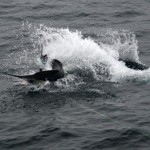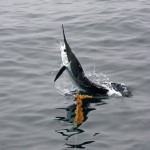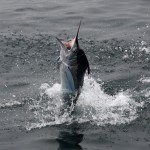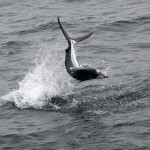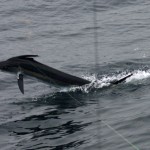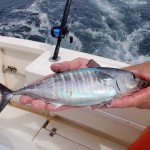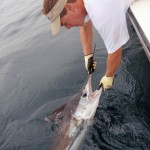Yesterday, we fished a little south of the Norfolk Canyon in 40 to 50 fathoms. Marlin fishing for us was slow. With the rain, I was not seeing them. I only saw two. One came in and did not bite anything. The other, we caught. Was hoping it was roundscale spearfish as we are trying to tag those things for Dr. John Graves. It turned out to be another white (now 27 whites in a row this month, without a roundscale). We caught 4 roundscales last year but now with the tagging study going on, we have not seen any. We had plenty of mystery bites and some of those were probably whites but there were a lot of dolphin, skipjack and other things around whacking at the baits. The one marlin put on a show and the rain stopped long enough for me to get out my camera. The top boat around us, caught 6 whites. There were a couple of blue marlin hooked up by the small fleet. In addition to the white, we caught 30 dolphin. Some were gaffed but none were what I would call a gaffer, nice bailers. We caught a variety of skipjack, false albacore, frigate tuna, and 2 young-of-the-year bluefin tuna.
A couple of weeks ago, we went out looking for YOY bluefin and did not find any. Brandon Bartlett told me that he had been catching some near the canyon this past week. We put out one little spoon in the middle of our marlin spread to see if any were around. That spoon got bit a bunch and we did get the 2 bluefin. We now know that there was another spawn down in the Gulf this past spring. I delivered the the tuna (and a couple of finlets collected by Brandon) to VIMS this morning. (note: collection of these fish is done under a closely regulated scientific permit process.)
Dr. Graves had a photo of a pop-up satellite tag. He asked me if it looked familiar. Most of his work with these tags has been with offshore fish. We did do a small study with striped bass (10 large fish) and then did some work with red drum. We put out one in a red drum to test the idea. Then we tagged 15 big reds one weekend (great fishing, caught a lot more than 15). There were some interesting insights shown about red drum (still waiting to read the final paper). One thing shown was a significant movement offshore of some of these large fish. John gave me 2 re-built tags (these tags can be re-used at a fraction of the cost of a new tag) to try to capture more information on this offshore activity. I was in our little boat, fishing by myself, when all 5 rods I had out, got clobbered by big red drum. I activated the tags and had a challenging fight to finally net the first fish while trying to keep the other 4 lines tight. Tagged and released that fish. Got the 2nd fish in and went to tag it. The tag was gone. I believe that I snagged it with the net and tossed it overboard while trying to land the first fish. The tags are suppose to transmit if they remain at the same depth for a specified time (as in a dead fish). We could go get it but this one did not show up during the normal reports. About a month later, John checked on that individual tag and it had been transmitting all that time (for some reason, not showing in his overall tag reports), but now the battery had died over that month so now we could not get it. We knew it was in the Eastern Shore marsh somewhere. Well, Irene changed that. My lost-forever-tag was recovered by a girl looking for seashells at Corolla after the storm. Makes me feel a little better about stupidly throwing one of those expensive tags overboard. Now the tag can be re-used again. Of interest, with the 10 striped bass and 17 red drum we caught on recreational tackle, and fitted with these tags, no mortality was seen.

